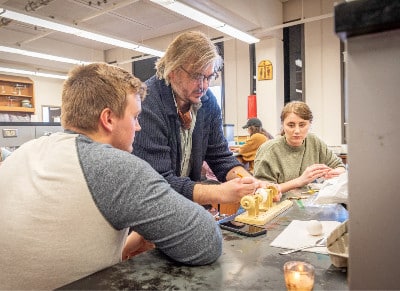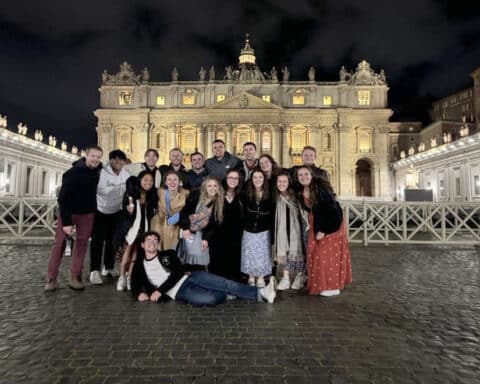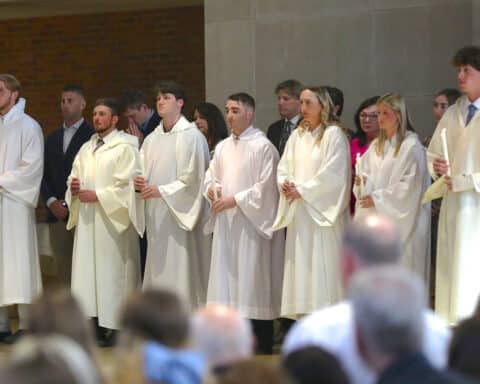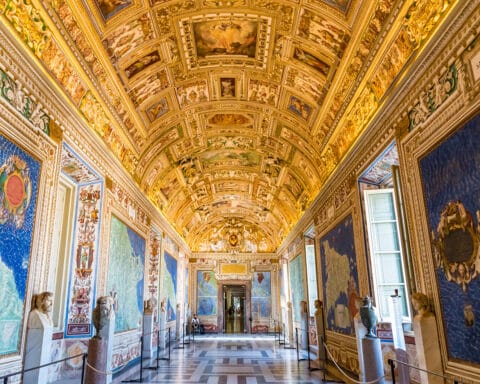The impact of the Catholic Church on Western civilization and culture is undeniable. At many Catholic colleges and universities, students learn about the role of the Church in the history of art — and the role the Catholic faith can continue to play in an artist’s creations.
The “Loyola Core” at Loyola University New Orleans includes a category called Creative Arts & Cultures. This is more than a general education requirement; the traditional priorities of Jesuit education are emphasized in this curriculum framework: critical thinking, quantitative reasoning, information literacy, effective communication and ethical reasoning. These priorities mean that students “not take courses and have experiences that are directly related to and engage the Catholic faith, but also many others that touch on values consistent with and even inspired by Catholic teaching but not explicitly about Catholicism or Christianity or religion,” said Jesuit Father Greg Waldrop, assistant professor of art history.
There are certainly times when classroom instruction is explicitly covering Catholic teaching. A student at another school once commented to Father Waldrop, “I’ve learned more about Catholicism in your course than I have in any of my required theology classes.” Sometimes coursework covers altarpieces, which necessitates instruction on altars and what happens on Catholic altars, liturgy, the Eucharist, prayer. Much of the history of western art is ensconced in the Catholic faith. But even peripherally, when discussing more recent art history when the Church was no longer such a prominent patron, there are ethical and moral issues to discuss — such as repatriation of looted antiquities — which is another way the Catholic faith is incorporated into coursework.
Read more Fall College section articles here.
“So one way or another I’m teaching the Faith, I’m talking to young people about Jesus, I’m getting them to read Bible passages, and I’m encouraging them to analyze correctly in hopes that acting justly flows naturally from that and becomes a lasting legacy of their Jesuit education,” Father Waldrop said.
But why teach art in college, anyway? Wouldn’t the students be better served to simply learn vocational skills?
“If college doesn’t prepare students for meaningful work in the world, then it fails,” Father Waldrop said. “But the Church is still the greatest defender of the notion that we are more than our jobs, careers, or professional successes. We have hearts and feelings, not to mention brains that ponder bigger things than spreadsheets or bond rates.”
Art, in particular, is one way that the university can accomplish this point of education. Art engages our hearts and minds, and beauty draws us into deeper contemplation. “We are more authentically human in such moments, and that’s why our colleges and universities mustn’t become solely professional training centers,” Father Waldrop said. “They have a spiritual mission as well.”
This was the experience of Bennett Plessala, who graduated in 2020 from Loyola New Orleans with a philosophy major and an art history minor. Much of art history is “a visual theology, comprised of complex Christian devotional art of many media all for the common goal of worshiping the Christian God,” he said. “To study this art without a deep guidance of faith is almost a waste of time and accomplishes very little.”
Guiding students toward wholeness
Angelo Ray Martínez is assistant professor and director of the visual arts program at Holy Cross College in Notre Dame, Indiana, where he has taught since 2017. The Catholic identity of Holy Cross guides all academic disciplines, and instructors are called to integrate aspects of the Faith into every class. While this may be easier in some courses than others, every professor is expected to present his discipline through a Catholic lens.
“Our mission is to ‘educate and form global citizens with the competence to see and the courage to act,'” Martínez said. “This is attained by applying the teachings of Christ to each course and exploring all subjects through the transcendentals of truth, beauty and goodness.”
In art classes, students are given many prompts for creative projects to explore features of our Catholic faith, including a painted portrait of love, a drawn response to a Scripture passage, or an artwork that addresses the goodness of creation. Students are encouraged to make their art a form of spiritual devotion.

“Teaching the Faith is the most important thing that we can do because it guides the individual toward wholeness,” Martínez said. Beyond simply preparing students for the workforce, there is an opportunity to show students how their faith can intersect with their chosen career paths, helping them better serve their communities in that way. “At Holy Cross College, we are dedicated to cultivating both the heart and the mind, to foster the next generation of great scholars, citizens, leaders and disciples!”
“In the studio art classes that I have taken so far, we as students are not only allowed to express our faith through our art, but are actively encouraged to do so,” said Cecilia Simerman, a junior graphic design major at Holy Cross. “The art we create means more to us than just a grade.” Simerman has a particular interest in religious art, and the support she has received from professors has motivated her to continue creating the kind of artwork that is most meaningful to her.
“I believe it is important for faith to be incorporated into art courses,” Simerman said. “The influence that the Catholic faith has had on the development of art over the centuries is undeniable, and a knowledge of that influence is necessary to fully appreciate the value of some of history’s greatest artworks.”
“I believe that faith can be communicated through art in such a beautiful way,” Simerman said. “It would be a shame if any aspiring artist were not given a chance to learn how to partake in that experience.”
Paul Senz writes from Oklahoma.





